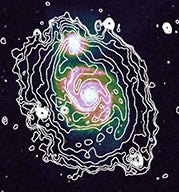The team viewed the Whirlpool Galaxy (M51), about 30 million light-years away, with the Low Frequency Array (LOFAR) radio telescope in the frequency range 115–175 megahertz, just above the normal commercial FM radio frequency band of 88–108 MHz. These results are the first LOFAR observations of a nearby galaxy.
LOFAR consists of 38 stations in the Netherlands, six stations in Germany, and one station each in the United Kingdom, France, and Sweden. The signals from all stations are then combined in a powerful computing cluster located at the University of Groningen in the Netherlands.
Radio astronomy shows two crucial components of galaxies that are invisible to optical telescopes — cosmic-ray electrons and magnetic fields — that play an important role in the stability and evolution of galaxies.
With LOFAR’s high sensitivity, the astronomers detected electrons and magnetic fields in the spiral arms and extended disk of M51, 40,000 light-years away from the galaxy’s center — much farther out than had ever been traced before.
“Low-frequency radio waves are important as they carry information about electrons of relatively low energies that are able to propagate farther away from their places of origin in the star-forming spiral arms and are able to illuminate the magnetic fields in the outer parts of galaxies,” said David Mulcahy from the University of Southampton in the United Kingdom. “We need to know whether magnetic fields are expelled from galaxies and what their strength is out there.”
“This beautiful image, coupled with the important scientific result it represents, illustrates the fantastic advances that can be made at low radio frequencies with the LOFAR telescope,” said Anna Scaife from the University of Southampton. “Unraveling the mysteries of magnetic fields is crucial to understanding how our universe works. For too long, many of the big questions about magnetic fields have simply been untestable, and this new era of radio astronomy is very exciting.”
For many decades, radio astronomy has been unable to explore low frequencies below 300 MHz because the ionosphere around Earth acts as a barrier of low-frequency radio waves. The only observations were of poor resolution, and no details could be made out.
“This opens a new window to the universe where we do not know what galaxies will look like,” said Rainer Beck from the Max Planck Institute of Radio Astronomy. “Maybe we will see how galaxies are magnetically connected to intergalactic space. This is a key experiment in preparation for the planned Square Kilometre Array that should tell us how cosmic magnetic fields are generated.”










